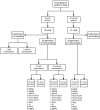Pan-viral screening of respiratory tract infections in adults with and without asthma reveals unexpected human coronavirus and human rhinovirus diversity
- PMID: 17703411
- PMCID: PMC7109683
- DOI: 10.1086/520816
Pan-viral screening of respiratory tract infections in adults with and without asthma reveals unexpected human coronavirus and human rhinovirus diversity
Abstract
Background: Between 50% and 80% of asthma exacerbations are associated with viral respiratory tract infections (RTIs), yet the influence of viral pathogen diversity on asthma outcomes is poorly understood because of the limited scope and throughput of conventional viral detection methods.
Methods: We investigated the capability of the Virochip, a DNA microarray-based viral detection platform, to characterize viral diversity in RTIs in adults with and without asthma.
Results: The Virochip detected viruses in a higher proportion of samples (65%) than did culture isolation (17%) while exhibiting high concordance (98%) with and comparable sensitivity (97%) and specificity (98%) to pathogen-specific polymerase chain reaction. A similar spectrum of viruses was identified in the RTIs of each patient subgroup; however, unexpected diversity among human coronaviruses (HCoVs) and human rhinoviruses (HRVs) was revealed. All but one of the HCoVs corresponded to the newly recognized HCoV-NL63 and HCoV-HKU1 viruses, and >20 different serotypes of HRVs were detected, including a set of 5 divergent isolates that formed a distinct genetic subgroup.
Conclusions: The Virochip can detect both known and novel variants of viral pathogens present in RTIs. Given the diversity detected here, larger-scale studies will be necessary to determine whether particular substrains of viruses confer an elevated risk of asthma exacerbation.
Conflict of interest statement
Potential conflicts of interest: none reported.
Figures






Comment in
-
Modernization of the medical Sherlock Holmes.J Infect Dis. 2007 Sep 15;196(6):810-1. doi: 10.1086/520820. Epub 2007 Aug 6. J Infect Dis. 2007. PMID: 17703409 Free PMC article. No abstract available.
References
-
- Johnston SL, Pattemore PK, Sanderson G, et al. The relationship between upper respiratory infections and hospital admissions for asthma: a time-trend analysis. Am J Respir Crit Care Med. 1996;154:654–60. - PubMed
Publication types
MeSH terms
Substances
Associated data
- Actions
- Actions
- Actions
- Actions
- Actions
- Actions
- Actions
- Actions
- Actions
- Actions
- Actions
- Actions
- Actions
- Actions
- Actions
- Actions
- Actions
- Actions
- Actions
- Actions
- Actions
- Actions
- Actions
- Actions
- Actions
- Actions
- Actions
- Actions
- Actions
- Actions
- Actions
- Actions
- Actions
- Actions
- Actions
- Actions
- Actions
- Actions
- Actions
- Actions
- Actions
- Actions
- Actions
- Actions
- Actions
Grants and funding
LinkOut - more resources
Full Text Sources
Other Literature Sources
Molecular Biology Databases

